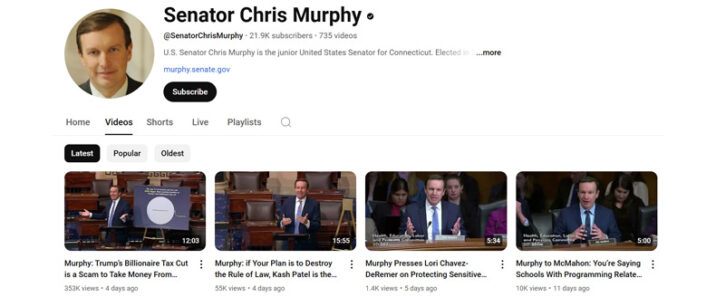Follow Epolitics on Substack, Bluesky, Threads, or Twitter/X. This post was also published on Substack
Elected Democrats are generally getting their hats handed to them on social media, despite some late efforts to catch up. But not all of them: Sen. Chris Murphy shows how digital effective digital communications actually works in today’s media environment. As spelled out over the weekend in the NYT [paywall], he’s capitalizing on the digital world’s ability to reach people directly and where they spend their time today.
Step one, create relevant content in many channels:
In two-minute videos on social media, which he records from his office on Capitol Hill; an almost constant stream of posts on X; passionate floor speeches; and essays he writes on his Substack, Mr. Murphy is attempting to explain in digestible sound bites that what is happening in Washington is very simple: It’s a billionaire takeover of American democracy.
Step two, meet the people where they get their information:
So Mr. Murphy has decided to set his hair on fire to get people to pay attention. He is on YouTube, doing interviews with Mr. Minaj and political influencers like Brian Tyler Cohen, Mehdi Hassan and Jack Cocchiarella. He is on Substack, talking to Anand Giridharadas. He is on TikTok talking to Aaron Parnas. And he is wherever you get your podcasts, talking to Jon Favreau.
Step three, amplify the results:
“The actual TV appearance has limited impact right now,” he said. “What you’re actually doing those TV appearances for is to create content that ultimately lives somewhere else.”
…“My 16-year-old son for the first time, he said to me, ‘What’s going on? My friends are seeing your stuff,'” Mr. Murphy said. “I’m showing up on a 16-year-old’s TikTok feed.”
Not surprisingly, he’s picking up new followers right and left, helping his words to spread even farther with every passing day.
Note that these ideas are not new and novel! I was leading blogger-relations (functionally, influencer-relations) trainings almost twenty years ago, and many of us have been talking about turning a single piece of information or content into a stream of communications for years. In my recent rapid-response and strategy trainings, I discussed how starting from a single item or idea, you might create:
- A series of posts on Facebook, Twitter/X, Bluesky and other social-media channels illustrating different aspects and implications of the story
- Memes, infographics or photo-posts that catch the eye or speak to the heart
- Short, casual videos featuring issue experts, people affected by the issue, activists, or in Chris Murphy’s case, the senator himself, amplified via social media
- Longer-form content on a blog, Substack or third-party publication, also distributed via social media
- Texts and emails to supporters to educate them and to ask for their help spreading the story through their own social channels (include one-click share links or links to a social-media toolkit to make it easy for them)
Then, use the content as fodder for outreach to podcasts, Substacks, YouTube channels, TV news, etc, once again promoting each segment individually as it comes out.
Digital advertising can play a role, since boosted content will reach more of an organization or officeholder’s followers on Facebook and Instagram than the same post would organically (in Sen. Murphy’s case, he’s also running Facebook fundraising ads at a higher volume than when he ran for reelection last year). Likewise, targeted ads could bring content to the attention of decisionmakers, for instance by connecting with segments of their constituents. And of course, grassroots organizers and activists can always take a message and run with it however they encounter it in the first place.
Naturally, creating all this content takes time! But AI tools, including ones designed for the progressive movement like Quiller, Change Agent and Sosha can ease the process, as can AI-assisted image-editing and video-editing apps.
The upshot? Press releases and CNN hits aren’t cutting it, and Democratic officeholders and advocacy groups need to be visible in today’s digital media spotlight. Prime fodder at this moment: Viral moments of constituents confronting Republican congressmembers at town halls about Trump’s power grab and assault on the Constitution. Organizations, activists and electeds should be spreading these far and wide, even if they have to go around censorship on X to do it. I’m not the only one reminded of the Tea Partiers protesting at Democratic Town Halls in 2009 and 2010, and we shall see how far the resistance spreads from there. The more the rest of us can amplify it, the better chance it has.
Who DOES get the new dynamic, BTW? The right wing media machine. As WaPo’s Phillip Bump quoted from a recent Jesse Watters Fox News segment:
“We are waging a 21st-century information warfare campaign against the left, and they are using tactics from the 1990s,” he said, mocking Democrats’ reliance on news conferences and traditional media stories. “What you’re seeing on the right is asymmetrical. It’s like grassroots guerrilla warfare. Someone says something on social media. Musk retweets it. [Joe] Rogan podcasts it. Fox broadcasts it. And by the time it reaches everybody, millions of people have seen it.”
If you’re a Democrat, or anyone else who doesn’t want to see the end of constitutional democracy in America, that’s what you’re up against. And it’s time to fight fire with fire.
– cpd

